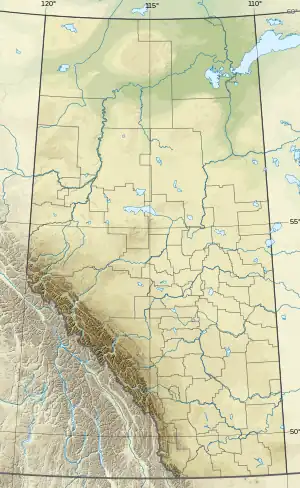Mount Murchison (Alberta)
Mount Murchison is a 3,353-metre (11,001 ft) mountain summit located at the convergence of the North Saskatchewan River valley and Mistaya River valley of Banff National Park, in the Canadian Rockies of Alberta, Canada. The main summit has two high points: the Southeast Peak is 3,353 m, whereas the Northwest Peak is 3,333 m and separated by 700 m distance. Its nearest higher peak is Mount Cline, 15.71 km (9.76 mi) to the north.[3] Mount Murchison is situated immediately southeast of the confluence of the North Saskatchewan River, Mistaya River, and Howse River near Saskatchewan Crossing, where the Icefields Parkway intersects with the David Thompson Highway.
| Mount Murchison | |
|---|---|
.jpeg.webp) Mount Murchison seen from Peyto Lake overlook at Bow Pass | |
| Highest point | |
| Elevation | 3,353 m (11,001 ft)[1] |
| Prominence | 993 m (3,258 ft)[1] |
| Parent peak | Mount Hector (3394 m)[1] |
| Listing | Mountains of Alberta |
| Coordinates | 51°55′59″N 116°40′30″W[2] |
| Naming | |
| Etymology | Roderick Murchison |
| Geography | |
 Mount Murchison Location of Mount Murchison in Alberta  Mount Murchison Mount Murchison (Canada) | |
| Location | Alberta, Canada |
| Parent range | Murchison Group Canadian Rockies |
| Topo map | NTS 82N15 Mistaya Lake[2] |
| Geology | |
| Age of rock | Cambrian |
| Type of rock | Sedimentary |
| Climbing | |
| First ascent | August 25, 1996 by Reg Bonney, Rick Collier, John Holmes, Jerre Skvaril[1] |
| Easiest route | technical climb |
History
Named by James Hector as he traversed the Mistaya Valley in September of 1858, Mount Murchison honors Sir Roderick Impey Murchison (1792-1871), a prominent English geologist and director of the Geological Survey of Great Britain.[4] The mountain's name became official in 1924.[2] The first ascent of the Northwest Peak was in 1902 by Norman Collie, H.E.M. Stutfield, G.M. Weed, and Hans Kaufmann.[5] The first ascent of the Southeast Peak was made August 25, 1996, by Reg Bonney, Rick Collier, John Holmes, and Jerre Skvaril.[1]
Geology
Like other mountains in Banff Park, the Murchison massif is composed of sedimentary rock laid down during the Precambrian to Jurassic periods.[6] Formed in shallow seas, this sedimentary rock was pushed east and over the top of younger rock during the Laramide orogeny.[7] The massif, which covers an area measuring five km by seven km (7400 acres), is characterized by seven rocky towers and glacial ice of the Murchison Icefield.
Towers of Murchison
| Name | Elevation | Prominence | First Ascent |
|---|---|---|---|
| Hall Tower | 3216 m | 183 m | 1940 |
| Bison Tower | 3185 m | 183 m | |
| Cromwell Tower | 3213 m | 28 m | |
| Feuz Tower | 3124 m | 183 m | 1941 |
| Gest Tower | 3170 m | 690 m | 1937 |
| South East Tower | 3094 m | 153 m | 1939 |
| Englehard Tower | 3216 m | 366 m |
Climate
Based on the Köppen climate classification, Mount Murchison is located in a subarctic climate with cold, snowy winters, and mild summers.[8] Temperatures can drop below -20 °C with wind chill factors below -30 °C. Weather conditions during winter make Mount Murchison a destination in the Rockies for ice climbing. Precipitation runoff from Mount Murchison drains into tributaries of the Saskatchewan River.
Ice Climbing Routes
Ice Climbing Routes with grades on Mount Murchison[9][10]
- But My Daddy's a Psycho - WI5
- Murchison Falls - WI4-5
- Virtual Reality - WI6
- Balfour Wall - WI 2-4
- Cosmic Messenger - WI5
- Imaginary Voyage - WI3
- Laughter in the Dark - WI4
- Alien Abduction - WI5
- Syndrome - WI6
Gallery
References
- "Mount Murchison". Bivouac.com. Retrieved 2018-10-14.
- "Mount Murchison". Geographical Names Data Base. Natural Resources Canada. Retrieved 2018-10-14.
- "Mount Murchison, Alberta". Peakbagger.com. Retrieved 2019-10-08.
- "Mount Murchison". cdnrockiesdatabases.ca. Retrieved 2019-10-08.
- "Mount Murchison NW Peak". Bivouac.com. Retrieved 2018-10-14.
- Belyea, Helen R. (1960). The Story of the Mountains in Banff National Park (PDF). parkscanadahistory.com (Report). Ottawa: Geological Survey of Canada. Archived (PDF) from the original on 2015-10-02. Retrieved 2019-09-13.
- Gadd, Ben (2008). Geology of the Rocky Mountains and Columbias.
- Peel, M. C.; Finlayson, B. L. & McMahon, T. A. (2007). "Updated world map of the Köppen−Geiger climate classification". Hydrol. Earth Syst. Sci. 11: 1633–1644. ISSN 1027-5606.
- Mount Murchison Mountain Project
- Mount Murchison SummitPost
External links
- Weather forecast: Mount Murchison
- Parks Canada web site: Banff National Park
- Explor8ion web site: Mount Murchison climb
- SummitSearch photo: Mount Murchison


